Nano-Pesticides and Fertilizers: Solutions for Global Food Security
Abstract
:1. Introduction
2. Overview of Nanotechnology
2.1. Definition and Basic Concepts of Nanotechnology
2.2. Preparation and Characterization of Nanomaterials
2.3. Nanotechnology in Agriculture
3. Nano-Fertilizers in Farming
3.1. Types of Nano-Fertilizers
3.2. Application of Nano-Nitrogen Fertilizer
3.3. Effectiveness of Nano Phosphate Fertilizer
3.4. Characteristics of Nano Potassium Fertilizer
3.5. Application Cases
3.6. Influencing Factors
4. Nano-Pesticides in Agriculture
4.1. Fundamentals of Nano-Pesticides
4.2. Pest Control Mechanisms
4.3. Advantages of Nano-Pesticides
5. Current Gaps of Nano Agrochemicals
6. Future Outlook
- Precision agriculture and smart agriculture innovation [86]:
- 2.
- Innovations in sustainable nano-pesticide and fertilizer design:
- 3.
- Gene editing combined with nanotechnology:
- 4.
- Social participation and education:
- 5.
- Global cooperation and standard setting:
- 6.
- Biosynthesis and sustainable production:
- 7.
- Nanotechnology and climate change adaptation:
Author Contributions
Funding
Data Availability Statement
Conflicts of Interest
References
- Townsend, J.W. Reproductive behavior in the context of global population. Am. Psychol. 2003, 58, 197–204. [Google Scholar] [CrossRef]
- Baulcombe, D.; Crute, I.; Davies, B.; Dunwell, J.; Gale, M.; Jones, J.; Pretty, J.; Sutherland, W.; Toulmin, C. Reaping the Benefits: Science and the Sustainable Intensification of Global Agriculture; The Royal Society: London, UK, 2009. [Google Scholar]
- Bank, W. World Development Report 2008: Agriculture for Development; The World Bank: Washington, DC, USA, 2007. [Google Scholar]
- Bhattacharya, A. Global climate change and its impact on agriculture. Chang. Clim. Resour. Use Effic. Plants 2019, 1, 1–50. [Google Scholar]
- Sun, Y.; Zhu, G.; Zhao, W.; Jiang, Y.; Wang, Q.; Wang, Q.; Rui, Y.; Zhang, P.; Gao, L. Engineered Nanomaterials for Improving the Nutritional Quality of Agricultural Products: A Review. Nanomaterials 2022, 12, 4219. [Google Scholar] [CrossRef] [PubMed]
- Godfray, H.C.J.; Beddington, J.R.; Crute, I.R.; Haddad, L.; Lawrence, D.; Muir, J.F.; Pretty, J.; Robinson, S.; Thomas, S.M.; Toulmin, C. Food Security: The Challenge of Feeding 9 Billion People. Science 2010, 327, 812–818. [Google Scholar] [CrossRef]
- Tyagi, P.K.; Arya, A.; Ramniwas, S.; Tyagi, S. Editorial: Recent trends in nanotechnology in precision and sustainable agriculture. Front. Plant Sci. 2023, 14, 1256319. [Google Scholar] [CrossRef] [PubMed]
- Mao, X.; Yang, Z. Chiral nanomaterial-enabled bactericide and nanopesticide for sustainable agriculture and food safety. J. Nanoparticle Res. 2023, 25, 198. [Google Scholar] [CrossRef]
- Smith, S.; Herling, B.; Zhang, C.; Beach, M.; Teo, S.; Gillies, E.; Johnston, A.; Such, G. Self-Immolative Polymer Nanoparticles with Precise and Controllable pH-Dependent Degradation. Biomacromolecules 2023, 24, 4958–4969. [Google Scholar] [CrossRef]
- Farokhzad, O.C.; Langer, R. Impact of Nanotechnology on Drug Delivery. ACS Nano 2009, 3, 16–20. [Google Scholar] [CrossRef]
- Harris, P.J.F. Carbon Nanotubes and Related Structures: New Materials for the Twenty-First Century; Cambridge University Press: Cambridge, UK, 1999. [Google Scholar] [CrossRef]
- Singh, N.B.; Jain, P.; De, A.; Tomar, R. Green Synthesis and Applications of Nanomaterials. Curr. Pharm. Biotechnol. 2021, 22, 1705–1747. [Google Scholar] [CrossRef]
- Gaillard, C.; Mech, A.; Wohlleben, W.; Babick, F.; Hodoroaba, V.-D.; Ghanem, A.; Weigel, S.; Rauscher, H. A technique-driven materials categorisation scheme to support regulatory identification of nanomaterials. Nanoscale Adv. 2019, 1, 781–791. [Google Scholar] [CrossRef]
- Mir, S.A.; Shah, M.A.; Mir, M.M.; Iqbal, U. New Horizons of Nanotechnology in Agriculture and Food Processing Industry. In Integrating Biologically-Inspired Nanotechnology into Medical Practice; IGI Global: Hershey, PA, USA, 2018; pp. 196–217. [Google Scholar]
- Qu, X.; Alvarez, P.J.J.; Li, Q. Applications of nanotechnology in water and wastewater treatment. Water Res. 2013, 47, 3931–3946. [Google Scholar] [CrossRef]
- Ingale, A.G.; Chaudhari, A.N. Nanotechnology in the Food Industry. In Nanotechnology, Food Security and Water Treatment; Gothandam, K.M., Ranjan, S., Dasgupta, N., Ramalingam, C., Lichtfouse, E., Eds.; Springer: Berlin/Heidelberg, Germany, 2018; Volume 11, pp. 87–128. [Google Scholar]
- Yetisen, A.K.; Qu, H.; Manbachi, A.; Butt, H.; Dokmeci, M.R.; Hinestroza, J.P.; Skorobogatiy, M.; Khademhosseini, A.; Yun, S.H. Nanotechnology in Textiles. ACS Nano 2016, 10, 3042–3068. [Google Scholar] [CrossRef]
- Sanchez, F.; Sobolev, K. Nanotechnology in concrete—A review. Constr. Build. Mater. 2010, 24, 2060–2071. [Google Scholar] [CrossRef]
- Liu, R.; Lal, R. Potentials of engineered nanoparticles as fertilizers for increasing agronomic productions. Sci. Total Environ. 2015, 514, 131–139. [Google Scholar] [CrossRef]
- Catita, J.A.M. Challenges in Nanomaterial Characterization—From Definition to Analysis. In Nanotoxicology in Safety Assessment of Nanomaterials; Louro, H., Silva, M.J., Eds.; Springer International Publishing: Cham, Switzerland, 2022; pp. 3–17. [Google Scholar]
- Sepeur, S. Nanotechnology: Technical Basics and Applications; Vincentz Network GmbH & Co KG: Hannover, Germany, 2008. [Google Scholar]
- Kokila, G.N.; Mallikarjunaswamy, C.; Ranganatha, V.L. A review on synthesis and applications of versatile nanomaterials. Inorg. Nano-Met. Chem. 2022, 1–30. [Google Scholar] [CrossRef]
- Salem, S.S.; Fouda, A. Green Synthesis of Metallic Nanoparticles and Their Prospective Biotechnological Applications: An Overview. Biol. Trace Elem. Res. 2021, 199, 344–370. [Google Scholar] [CrossRef]
- Tang, S.; Liang, J.; Li, O.; Shao, N.; Jin, Y.; Ni, J.; Fei, X.; Li, Z. Morphology-Tailored Hydroxyapatite Nanocarrier for Rhizosphere-Targeted Phosphorus Delivery. Small 2023, 19, e2206954. [Google Scholar] [CrossRef]
- Khodakovskaya, M.V.; Kim, B.-S.; Kim, J.N.; Alimohammadi, M.; Dervishi, E.; Mustafa, T.; Cernigla, C.E. Carbon Nanotubes as Plant Growth Regulators: Effects on Tomato Growth, Reproductive System, and Soil Microbial Community. Small 2013, 9, 115–123. [Google Scholar] [CrossRef]
- Rathinavel, S.; Priyadharshini, K.; Panda, D. A review on carbon nanotube: An overview of synthesis, properties, functionalization, characterization, and the application. Mater. Sci. Eng. B 2021, 268, 115095. [Google Scholar] [CrossRef]
- Pulskamp, K.; Diabaté, S.; Krug, H.F. Carbon nanotubes show no sign of acute toxicity but induce intracellular reactive oxygen species in dependence on contaminants. Toxicol. Lett. 2007, 168, 58–74. [Google Scholar] [CrossRef]
- Sun, Z.; Liu, Z.; Meng, J.; Duan, J.; Xie, S.; Lu, X.; Zhu, Z.; Wang, C.; Chen, S.; Xu, H.; et al. Carbon Nanotubes Enhance Cytotoxicity Mediated by Human Lymphocytes In Vitro. PLoS ONE 2011, 6, e21073. [Google Scholar] [CrossRef] [PubMed]
- Chakravarty, D.; Erande, M.B.; Late, D.J. Graphene quantum dots as enhanced plant growth regulators: Effects on coriander and garlic plants. J. Sci. Food Agric. 2015, 95, 2772–2778. [Google Scholar] [CrossRef] [PubMed]
- Hack, R.; Correia, C.H.G.; Zanon, R.A.D.; Pezzin, S.H. Characterization of graphene nanosheets obtained by a modified Hummer’s method. Mater.-Rio De Jan. 2018, 23. [Google Scholar] [CrossRef]
- Begum, P.; Ikhtiari, R.; Fugetsu, B. Graphene phytotoxicity in the seedling stage of cabbage, tomato, red spinach, and lettuce. Carbon 2011, 49, 3907–3919. [Google Scholar] [CrossRef]
- Du, J.; Hu, X.; Zhou, Q. Graphene oxide regulates the bacterial community and exhibits property changes in soil. RSC Adv. 2015, 5, 27009–27017. [Google Scholar] [CrossRef]
- Torney, F.; Trewyn, B.G.; Lin, V.S.Y.; Wang, K. Mesoporous silica nanoparticles deliver DNA and chemicals into plants. Nat. Nanotechnol. 2007, 2, 295–300. [Google Scholar] [CrossRef]
- Zhang, Y.; Zhou, C.; Wang, X.; Yang, T.; Xu, Y. Preparation and Characterization of Organo-Functionalized Mesoporous Silica. Prog. Chem. 2008, 20, 33–41. [Google Scholar]
- Gajjar, P.; Pettee, B.; Britt, D.W.; Huang, W.; Johnson, W.P.; Anderson, A.J. Antimicrobial activities of commercial nanoparticles against an environmental soil microbe, Pseudomonas putida KT2440. J. Biol. Eng. 2009, 3, 9. [Google Scholar] [CrossRef]
- Sanzari, I.; Leone, A.; Ambrosone, A. Nanotechnology in Plant Science: To Make a Long Story Short. Front. Bioeng. Biotechnol. 2019, 7, 120. [Google Scholar] [CrossRef]
- Hu, Q.; Wujcik, E.K.; Kelarakis, A.; Cyriac, J.; Gong, X. Carbon-Based Nanomaterials as Novel Nanosensors. J. Nanomater. 2017, 2017, 3643517. [Google Scholar] [CrossRef]
- Chhipa, H. Nanofertilizers and nanopesticides for agriculture. Environ. Chem. Lett. 2017, 15, 15–22. [Google Scholar] [CrossRef]
- Upadhyay, P.K.; Singh, V.K.; Rajanna, G.A.; Dwivedi, B.S.; Dey, A.; Singh, R.K.; Rathore, S.S.; Shekhawat, K.; Babu, S.; Singh, T.; et al. Unveiling the combined effect of nano fertilizers and conventional fertilizers on crop productivity, profitability, and soil well-being. Front. Sustain. Food Syst. 2023, 7, 1260178. [Google Scholar] [CrossRef]
- Servin, A.; Elmer, W.; Mukherjee, A.; De La Torre Roche, R.; Hamdi, H.; White, J.; Bindraban, P.S.; Dimkpa, C. A review of the use of engineered nanomaterials to suppress plant disease and enhance crop yield. J. Nanoparticle Res. 2015, 17, 92. [Google Scholar] [CrossRef]
- Nongbet, A.; Mishra, A.K.; Mohanta, Y.K.; Mahanta, S.; Ray, M.K.; Khan, M.; Baek, K.-H.; Chakrabartty, I. Nanofertilizers: A Smart and Sustainable Attribute to Modern Agriculture. Plants 2022, 11, 2587. [Google Scholar] [CrossRef]
- Uzu, G.; Sobanska, S.; Sarret, G.; Muñoz, M.; Dumat, C. Foliar lead uptake by lettuce exposed to atmospheric fallouts. Environ. Sci. Technol. 2010, 44, 1036–1042. [Google Scholar] [CrossRef]
- Silva, L.C.D.; Oliva, M.A.; Azevedo, A.A.; Araújo, J.M.D. Responses of restinga plant species to pollution from an iron pelletization factory. Water Air Soil Pollut. 2006, 175, 241–256. [Google Scholar] [CrossRef]
- Vaghela, U.; Sonagara, M.K.; Patel, K. Nano-Biofortification: An Environmental Health Overview. In Nano-Biofortification for Human and Environmental Health; Rajput, V.D., El-Ramady, H., Upadhyay, S.K., Minkina, T., Ahmed, B., Mandzhieva, S., Eds.; Springer International Publishing: Cham, Switzerland, 2023; pp. 77–98. [Google Scholar]
- Gao, M.; Chang, J.; Wang, Z.; Zhang, H.; Wang, T. Advances in transport and toxicity of nanoparticles in plants. J. Nanobiotechnology 2023, 21, 75. [Google Scholar] [CrossRef]
- Singh, P.; Singh, R.; Verma, P.; Bhadouria, R.; Kumar, A.; Kaushik, M. Plant-Microbes-Engineered Nano-Particles (PM-ENPs) Nexus in Agro-Ecosystems; Springer: Berlin/Heidelberg, Germany, 2021. [Google Scholar]
- Jia, G.; Wang, H.; Yan, L.; Wang, X.; Pei, R.; Yan, T.; Zhao, Y.; Guo, X. Cytotoxicity of carbon nanomaterials: Single-wall nanotube, multi-wall nanotube, and fullerene. Environ. Sci. Technol. 2005, 39, 1378–1383. [Google Scholar] [CrossRef]
- Naaz, H.; Rawat, K.; Saffeullah, P.; Umar, S. Silica nanoparticles synthesis and applications in agriculture for plant fertilization and protection: A review. Environ. Chem. Lett. 2023, 21, 539–559. [Google Scholar] [CrossRef]
- Rico, C.M.; Majumdar, S.; Duarte-Gardea, M.; Peralta-Videa, J.R.; Gardea-Torresdey, J.L. Interaction of Nanoparticles with Edible Plants and Their Possible Implications in the Food Chain. J. Agric. Food Chem. 2011, 59, 3485–3498. [Google Scholar] [CrossRef]
- Kumar, N.; Samota, S.R.; Venkatesh, K.; Tripathi, S.C. Global trends in use of nano-fertilizers for crop production: Advantages and constraints—A review. Soil Tillage Res. 2023, 228, 105645. [Google Scholar] [CrossRef]
- Pitambara; Archana; Shukla, Y.M. Nanofertilizers: A Recent Approach in Crop Production. In Nanotechnology for Agriculture: Crop Production & Protection; Panpatte, D.G., Jhala, Y.K., Eds.; Springer: Singapore, 2019; pp. 25–58. [Google Scholar]
- Fincheira, P.; Hoffmann, N.; Tortella, G.; Ruiz, A.; Cornejo, P.; Diez, M.C.; Seabra, A.B.; Benavides-Mendoza, A.; Rubilar, O. Eco-Efficient Systems Based on Nanocarriers for the Controlled Release of Fertilizers and Pesticides: Toward Smart Agriculture. Nanomaterials 2023, 13, 1978. [Google Scholar] [CrossRef] [PubMed]
- Kopittke, P.M.; Lombi, E.; Wang, P.; Schjoerring, J.K.; Husted, S. Nanomaterials as fertilizers for improving plant mineral nutrition and environmental outcomes. Environ. Sci. Nano 2019, 6, 3513–3524. [Google Scholar] [CrossRef]
- Upadhyay, P.K.; Dey, A.; Singh, V.K.; Dwivedi, B.S.; Singh, T.; Rajanna, G.A.; Babu, S.; Rathore, S.S.; Singh, R.K.; Shekhawat, K.; et al. Conjoint application of nano-urea with conventional fertilizers: An energy efficient and environmentally robust approach for sustainable crop production. PLoS ONE 2023, 18, e0284009. [Google Scholar] [CrossRef] [PubMed]
- McKnight, M.M.; Qu, Z.; Copeland, J.K.; Guttman, D.S.; Walker, V.K. A practical assessment of nano-phosphate on soybean (Glycine max) growth and microbiome establishment. Sci. Rep. 2020, 10, 9151. [Google Scholar] [CrossRef] [PubMed]
- Rajendran, M.; Celsia, R.; Bharathi, S.; Blessina, S.; Maheswari, U. Evaluation of Nano Structured Slow Release Fertilizer on the Soil Fertility, Yield and Nutritional Profile of Vigna radiata. Recent Pat. Nanotechnol. 2016, 11, 50–62. [Google Scholar] [CrossRef]
- Saad, A.; Alabdali, A.; Ebaid, M.; Salama, E.; Alshamrani, S.; El-Saadony, M.; Selim, S.; Safhi, F.; Abdalla, H.; Mahdi, A.; et al. Impact of Green Chitosan Nanoparticles Fabricated from Shrimp Processing Waste as a Source of Nano Nitrogen Fertilizers on the Yield Quantity and Quality of Wheat (Triticum aestivum L.) Cultivars. Molecules 2022, 27, 5640. [Google Scholar] [CrossRef] [PubMed]
- Sadati Valojai, S.T.; Niknejad, Y.; Fallah Amoli, H.; Barari Tari, D. Response of rice yield and quality to nano-fertilizers in comparison with conventional fertilizers. J. Plant Nutr. 2021, 44, 1971–1981. [Google Scholar] [CrossRef]
- Joshi, A.; Kaur, S.; Dharamvir, K.; Nayyar, H.; Verma, G. Multi-walled carbon nanotubes applied through seed-priming influence early germination, root hair, growth and yield of bread wheat (Triticum aestivum L.). J. Sci. Food Agric. 2018, 98, 3148–3160. [Google Scholar] [CrossRef]
- Zhou, P.; Adeel, M.; Shakoor, N.; Guo, M.; Hao, Y.; Azeem, I.; Li, M.; Liu, M.; Rui, Y. Application of Nanoparticles Alleviates Heavy Metals Stress and Promotes Plant Growth: An Overview. Nanomaterials 2021, 11, 26. [Google Scholar] [CrossRef]
- D’Odorico, P.; Davis, K.; Rosa, L.; Carr, J.; Chiarelli, D.; Dell’Angelo, J.; Gephart, J.; MacDonald, G.; Seekell, D.; Suweis, S.; et al. The Global Food-Energy-Water Nexus. Rev. Geophys. 2018, 56, 456–531. [Google Scholar] [CrossRef]
- Wang, Y.; Tan, W.; Rui, Y. Migration and transformation of Engineering nanomaterials in soil and its influencing factors. Fresenius Environ. Bull. 2018, 27, 590–599. [Google Scholar]
- Wong, M.H.; Misra, R.; Giraldo, J.; Kwak, S.-Y.; Son, Y.; Landry, M.; Swan, J.; Blankschtein, D.; Strano, M. Lipid Exchange Envelope Penetration (LEEP) of Nanoparticles for Plant Engineering: A Universal Localization Mechanism. Nano Lett. 2016, 16, 1161–1172. [Google Scholar] [CrossRef] [PubMed]
- Abdul Razak, N.Q.; Md Yusoff, M.H.; Abdul Aziz, W.N.A.; Kamal, M.L.; Hasan, S.; Uyup, N.H.; Zulkffle, M.A.; Mohamed Hussin, N.A.; Shafie, M.H. Effects of silver nanoparticles on seed germination and seedling growth: A review. J. Indian Chem. Soc. 2023, 100, 100866. [Google Scholar] [CrossRef]
- Dimkpa, C.O.; Bindraban, P.S. Nanofertilizers: New Products for the Industry? J. Agric. Food Chem. 2018, 66, 6462–6473. [Google Scholar] [CrossRef] [PubMed]
- Ullah, S.; Adeel, M.; Zain, M.; Rizwan, M.; Irshad, M.K.; Jilani, G.; Hameed, A.; Khan, A.; Arshad, M.; Raza, A.; et al. Physiological and biochemical response of wheat (Triticum aestivum) to TiO2 nanoparticles in phosphorous amended soil: A full life cycle study. J. Environ. Manag. 2020, 263, 110365. [Google Scholar] [CrossRef] [PubMed]
- Janmohammadi, M.; Navid, A.; Ebadi, A.; Sabaghnia, N. Impact of nano-chelated micronutrients and biological fertilizers on growth performance and grain yield of maize under deficit irrigation condition. Biologija 2016, 62. [Google Scholar] [CrossRef]
- Kah, M.; Kookana, R.S.; Gogos, A.; Bucheli, T.D. A critical evaluation of nanopesticides and nanofertilizers against their conventional analogues. Nat. Nanotechnol. 2018, 13, 677–684. [Google Scholar] [CrossRef]
- Zulfiqar, F.; Navarro, M.; Ashraf, M.; Akram, N.A.; Munné-Bosch, S. Nanofertilizer use for sustainable agriculture: Advantages and limitations. Plant Sci. Int. J. Exp. Plant Biol. 2019, 289, 110270. [Google Scholar] [CrossRef]
- Adisa, I.; Pullagurala, V.; Peralta-videa, J.; Dimkpa, C.; Gardea-Torresdey, J.; White, J. Recent advances in nano-enabled fertilizers and pesticides: A critical review of mechanisms of action. Environ. Sci. Nano 2019, 6, 2002–2030. [Google Scholar] [CrossRef]
- Sun, C.; Zeng, Z.; Cui, H.; Verheggen, F. Polymer-based nanoinsecticides: Current developments, environmental risks and future challenges. A review. BASE 2020, 24, 59–69. [Google Scholar] [CrossRef]
- Wang, N.; Wang, B.; Wan, Y.; Gao, B.; Rajput, V.D. Alginate-based composites as novel soil conditioners for sustainable applications in agriculture: A critical review. J. Environ. Manag. 2023, 348, 119133. [Google Scholar] [CrossRef] [PubMed]
- Ray, P.; Alhalhooly, L.; Ghosh, A.; Choi, Y.; Banerjee, S.; Mallik, S.; Banerjee, S.; Quadir, M. Size-transformable, multifunctional nanoparticles from hyperbranched polymers for environment-specific therapeutic delivery. ACS Biomater. Sci. Eng. 2019, 5, 1354–1365. [Google Scholar] [CrossRef] [PubMed]
- Gao, Y.; Xiao, Y.; Mao, K.; Qin, X.; Zhang, Y.; Li, D.; Zhang, Y.; Li, J.; Wan, H.; He, S. Thermoresponsive polymer-encapsulated hollow mesoporous silica nanoparticles and their application in insecticide delivery. Chemical Engineering Journal 2019, 383, 123169. [Google Scholar] [CrossRef]
- Xu, Z.; Tang, T.; Lin, Q.; Yu, J.; Zhang, C.; Zhao, X.; Kah, M.; Li, L. Environmental risks and the potential benefits of nanopesticides: A review. Environ. Chem. Lett. 2022, 20, 2097–2108. [Google Scholar] [CrossRef]
- Walker, G.W.; Kookana, R.S.; Smith, N.E.; Kah, M.; Doolette, C.L.; Reeves, P.T.; Lovell, W.; Anderson, D.J.; Turney, T.W.; Navarro, D.A. Ecological Risk Assessment of Nano-enabled Pesticides: A Perspective on Problem Formulation. J. Agric. Food Chem. 2018, 66, 6480–6486. [Google Scholar] [CrossRef] [PubMed]
- Abd El-Azeim, M.M.; Sherif, M.A.; Hussien, M.S.; Tantawy, I.A.A.; Bashandy, S.O. Impacts of nano- and non-nanofertilizers on potato quality and productivity. Acta Ecol. Sin. 2020, 40, 388–397. [Google Scholar] [CrossRef]
- Chen, J.; Wang, W.; Xu, Y.; Zhang, X. Slow-Release Formulation of a New Biological Pesticide, Pyoluteorin, with Mesoporous Silica. J. Agric. Food Chem. 2011, 59, 307–311. [Google Scholar] [CrossRef]
- Kah, M.; Hofmann, T. Nanopesticide research: Current trends and future priorities. Environ. Int. 2014, 63, 224–235. [Google Scholar] [CrossRef]
- Wang, D.; Saleh, N.B.; Byro, A.; Zepp, R.; Sahle-Demessie, E.; Luxton, T.P.; Ho, K.T.; Burgess, R.M.; Flury, M.; White, J.C.; et al. Nano-enabled pesticides for sustainable agriculture and global food security. Nat. Nanotechnol. 2022, 17, 347–360. [Google Scholar] [CrossRef]
- Ma, C.; Borgatta, J.; Hudson, B.G.; Tamijani, A.A.; De La Torre-Roche, R.; Zuverza-Mena, N.; Shen, Y.; Elmer, W.; Xing, B.; Mason, S.E.; et al. Advanced material modulation of nutritional and phytohormone status alleviates damage from soybean sudden death syndrome. Nat. Nanotechnol. 2020, 15, 1033–1042. [Google Scholar] [CrossRef] [PubMed]
- Luo, X.; Zhao, J.; Li, M.; Zhao, X.; Wei, X.; Luo, Z.; Gu, W.; Du, D.; Lin, Y.; Zhu, C. Single-atom materials for food safety. Mater. Today 2023, 64, 121–137. [Google Scholar] [CrossRef]
- Wang, Q.; Zhao, W.; Li, Y.; Jiang, Y.; Yukui, R.; Guo, Z.; Lynch, I. Interplay of metal-based nanoparticles with plant rhizosphere microenvironment: Implications for nanosafety and nano-enabled sustainable agriculture. Environ. Sci. Nano 2023, 10, 372–392. [Google Scholar] [CrossRef]
- Singh, H.; Sharma, A.; Kumar, S.; Arya, S.; Bhardwaj, N.; Khatri, M. Recent advances in applications of nano-agrochemicals for sustainable agricultural development. Environ. Sci. Process. Impacts 2021, 23, 213–239. [Google Scholar] [CrossRef] [PubMed]
- Bartolucci, C.; Scognamiglio, V.; Antonacci, A.; Fraceto, L.F. What makes nanotechnologies applied to agriculture green? Nano Today 2022, 43, 101389. [Google Scholar] [CrossRef]
- Zhang, P.; Guo, Z.; Ullah, S.; Melagraki, G.; Afantitis, A.; Lynch, I. Nanotechnology and artificial intelligence to enable sustainable and precision agriculture. Nat. Plants 2021, 7, 864–876. [Google Scholar] [CrossRef]
- Parisi, C.; Vigani, M.; Rodríguez-Cerezo, E. Agricultural Nanotechnologies: What are the current possibilities? Nano Today 2014, 10, 124–127. [Google Scholar] [CrossRef]
- Pandey, G. Challenges and future prospects of agri-nanotechnology for sustainable agriculture in India. Environ. Technol. Innov. 2018, 11, 299–307. [Google Scholar] [CrossRef]
- Iavicoli, I.; Leso, V.; Beezhold, D.H.; Shvedova, A.A. Nanotechnology in agriculture: Opportunities, toxicological implications, and occupational risks. Toxicol. Appl. Pharmacol. 2017, 329, 96–111. [Google Scholar] [CrossRef]
- Mouchlis, V.D.; Afantitis, A.; Serra, A.; Fratello, M.; Papadiamantis, A.G.; Aidinis, V.; Lynch, I.; Greco, D.; Melagraki, G. Advances in De Novo Drug Design: From Conventional to Machine Learning Methods. Int. J. Mol. Sci. 2021, 22, 1676. [Google Scholar] [CrossRef]
- Shakil Hussain, S.M.; Kamal, M.S.; Hossain, M.K. Recent Developments in Nanostructured Palladium and Other Metal Catalysts for Organic Transformation. J. Nanomater. 2019, 2019, 1562130. [Google Scholar] [CrossRef]
- Demirer, G.S.; Silva, T.N.; Jackson, C.T.; Thomas, J.B.; Ehrhardt, D.W.; Rhee, S.Y.; Mortimer, J.C.; Landry, M.P. Nanotechnology to advance CRISPR–Cas genetic engineering of plants. Nat. Nanotechnol. 2021, 16, 243–250. [Google Scholar] [CrossRef] [PubMed]
- Ahmadi, M.; Ahmadi, L. Ethical Considerations of Nanobiotechnology. J. Biomater. Tissue Eng. 2013, 3, 335–352. [Google Scholar] [CrossRef]
- Alehosseini, E.; Jafari, S.M. Nanoencapsulation of phase change materials (PCMs) and their applications in various fields for energy storage and management. Adv. Colloid Interface Sci. 2020, 283, 102226. [Google Scholar] [CrossRef]
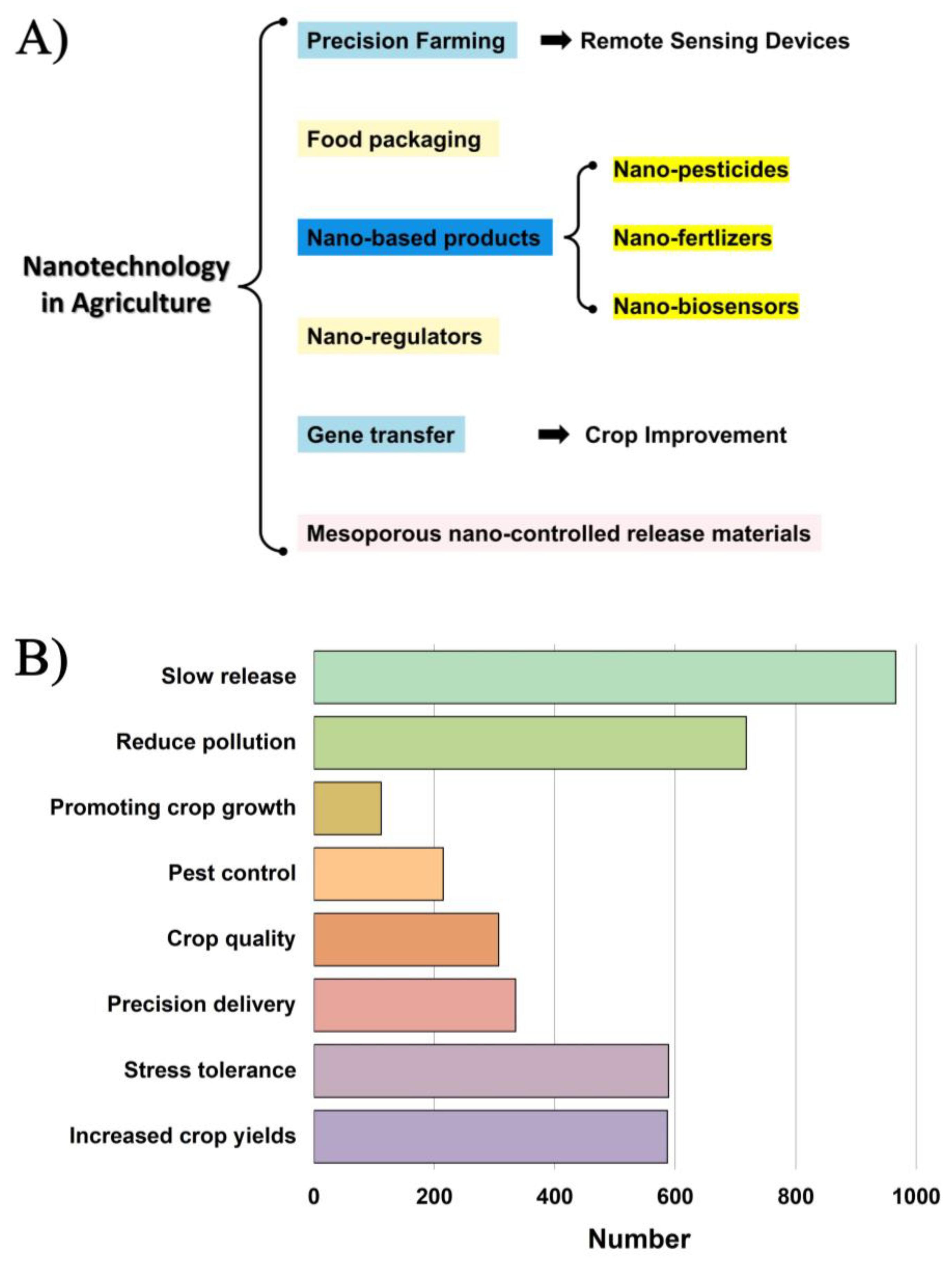
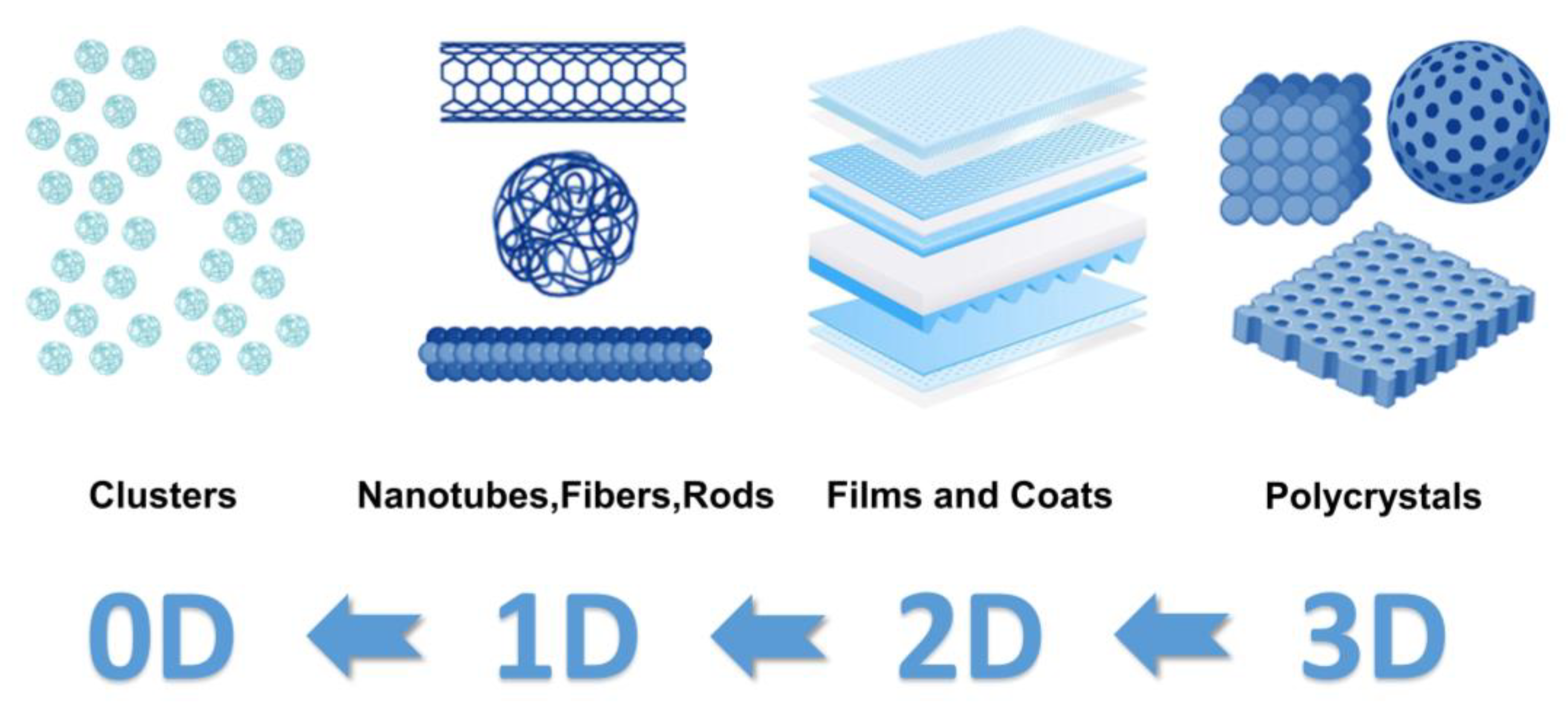
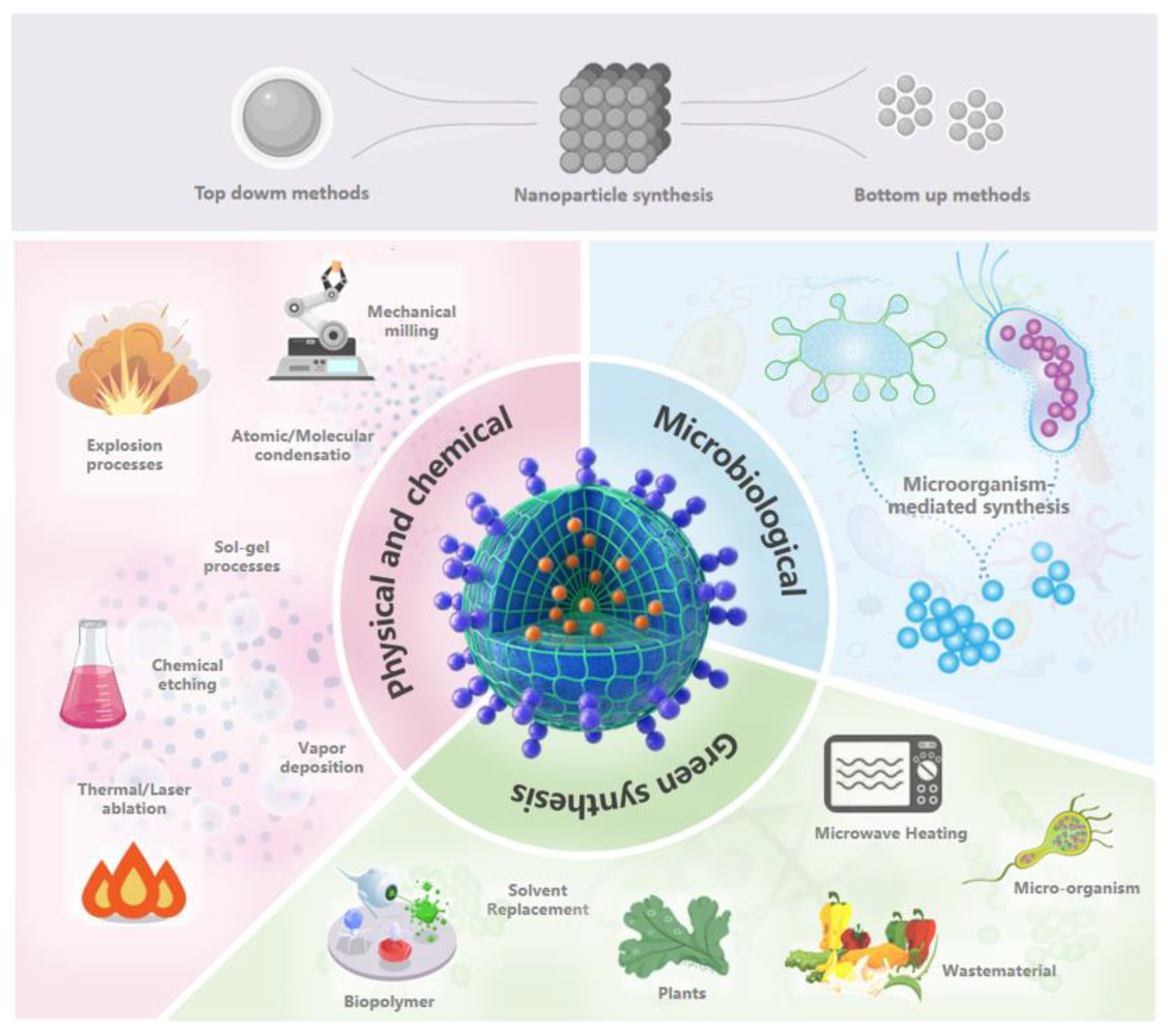
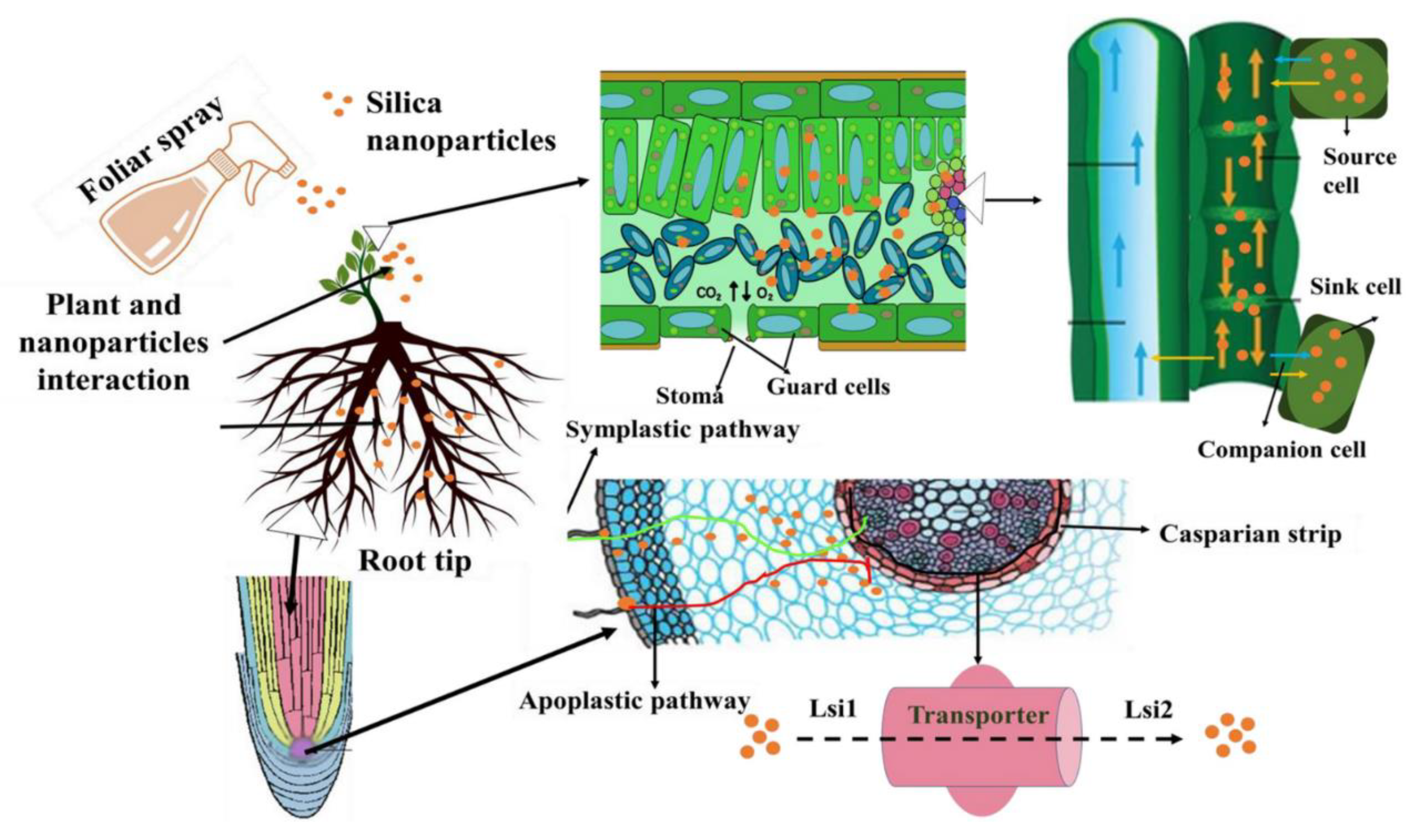
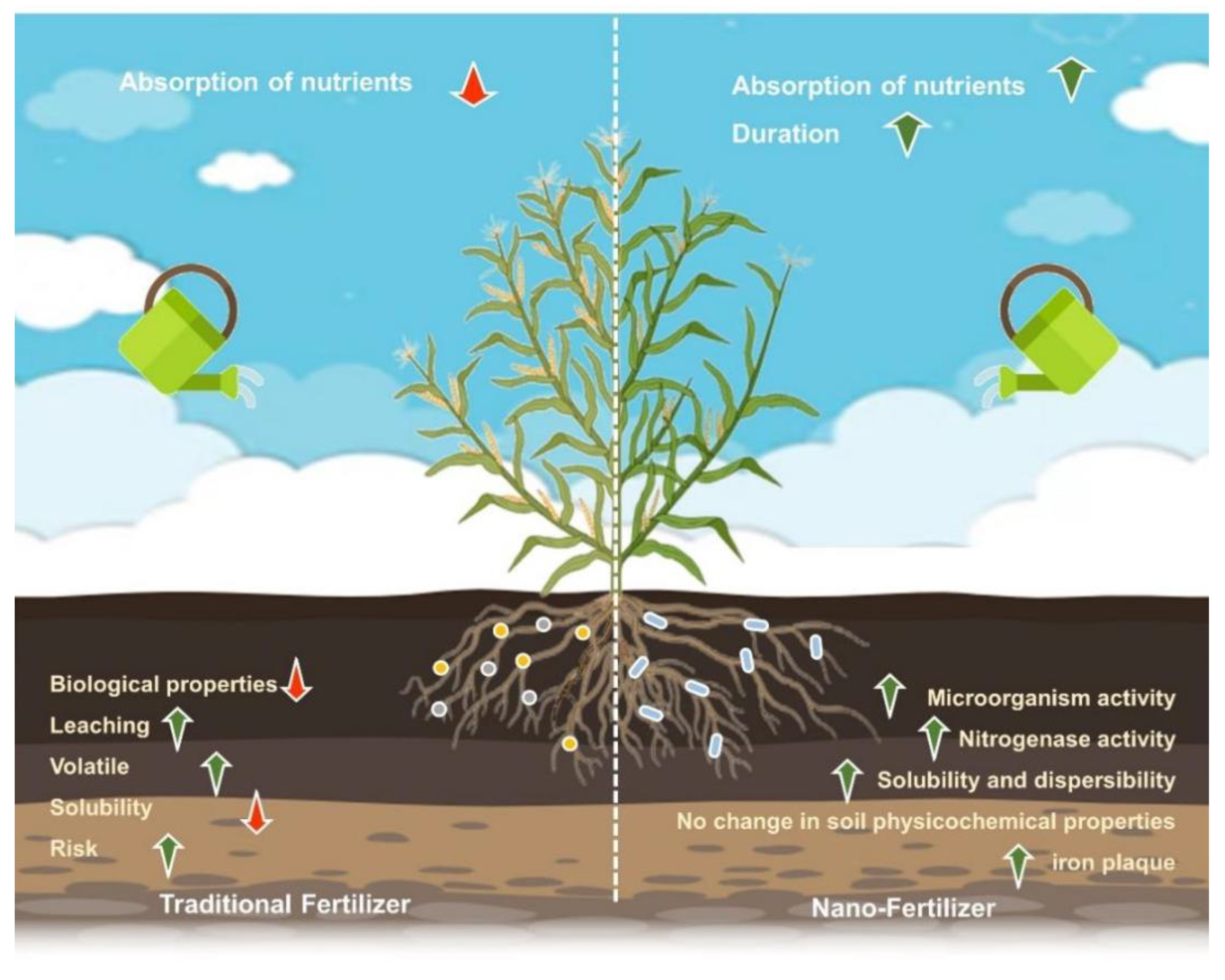
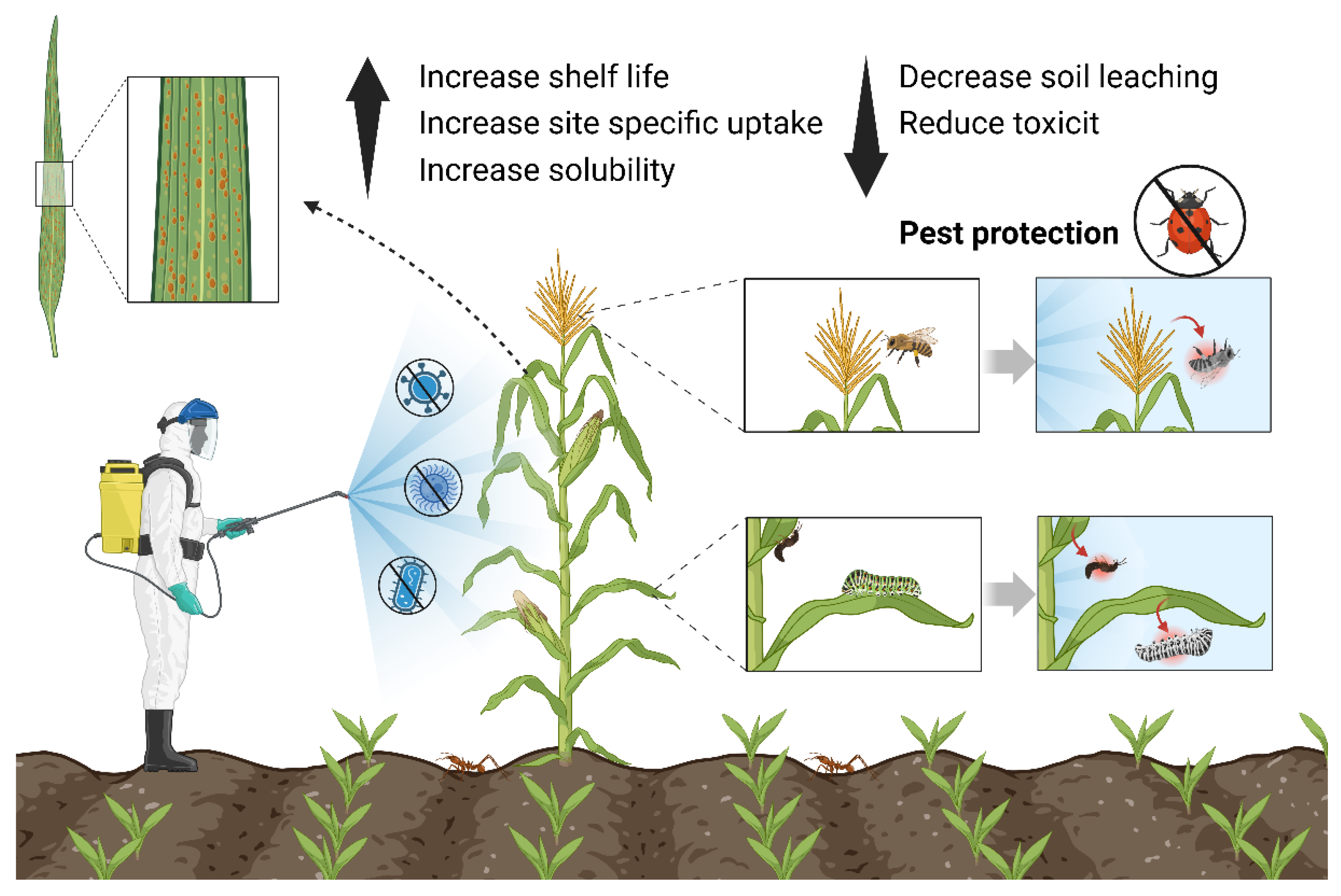
| Classification | Method | Differences | Applications | Cases |
|---|---|---|---|---|
| Physical synthesis | Vapor deposition, sputtering | Does not involve chemical reactions and relies heavily on physical processes | Preparation of nanomaterials with high crystallinity and purity, such as nanofilms, nanowires and nanoparticles | Nano-fertilizers |
| Chemical synthesis | Solution methods, hydrothermal synthesis | Involves a chemical reaction, usually requiring solvents, catalysts, specific reaction conditions | Suitable for the preparation of nanomaterials with high purity and high crystallinity | Biosensors, nanodrug delivery, nano-pesticides |
| Bio-synthesis | Microbes, plants or biomolecules | Involves bio-reductive or biosynthetic processes that are defined by the biology of the biological system and the growing circumstances. | Can be used in biomedical applications with natural biocompatibility | Nano drug carriers, biosensors |
Disclaimer/Publisher’s Note: The statements, opinions and data contained in all publications are solely those of the individual author(s) and contributor(s) and not of MDPI and/or the editor(s). MDPI and/or the editor(s) disclaim responsibility for any injury to people or property resulting from any ideas, methods, instructions or products referred to in the content. |
© 2023 by the authors. Licensee MDPI, Basel, Switzerland. This article is an open access article distributed under the terms and conditions of the Creative Commons Attribution (CC BY) license (https://creativecommons.org/licenses/by/4.0/).
Share and Cite
Tang, Y.; Zhao, W.; Zhu, G.; Tan, Z.; Huang, L.; Zhang, P.; Gao, L.; Rui, Y. Nano-Pesticides and Fertilizers: Solutions for Global Food Security. Nanomaterials 2024, 14, 90. https://doi.org/10.3390/nano14010090
Tang Y, Zhao W, Zhu G, Tan Z, Huang L, Zhang P, Gao L, Rui Y. Nano-Pesticides and Fertilizers: Solutions for Global Food Security. Nanomaterials. 2024; 14(1):90. https://doi.org/10.3390/nano14010090
Chicago/Turabian StyleTang, Yuying, Weichen Zhao, Guikai Zhu, Zhiqiang Tan, Lili Huang, Peng Zhang, Li Gao, and Yukui Rui. 2024. "Nano-Pesticides and Fertilizers: Solutions for Global Food Security" Nanomaterials 14, no. 1: 90. https://doi.org/10.3390/nano14010090
APA StyleTang, Y., Zhao, W., Zhu, G., Tan, Z., Huang, L., Zhang, P., Gao, L., & Rui, Y. (2024). Nano-Pesticides and Fertilizers: Solutions for Global Food Security. Nanomaterials, 14(1), 90. https://doi.org/10.3390/nano14010090








